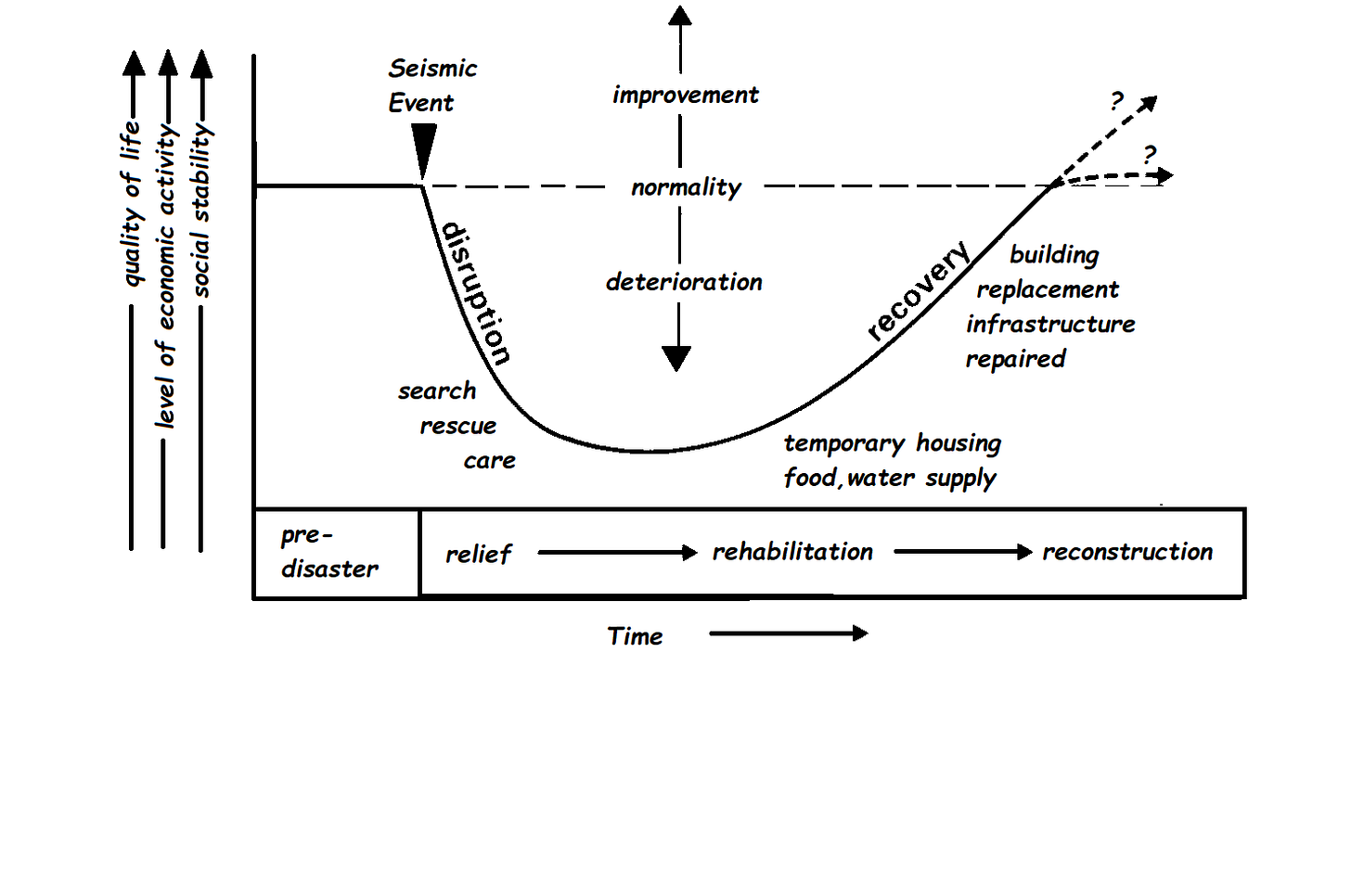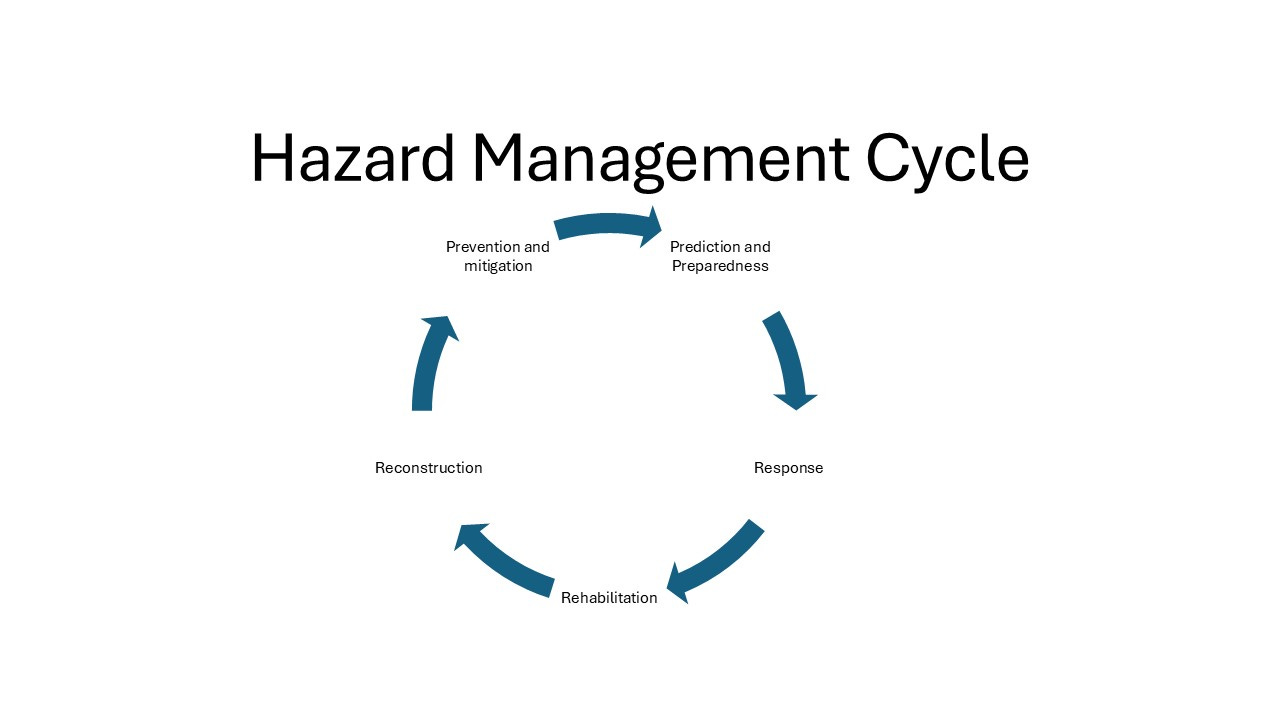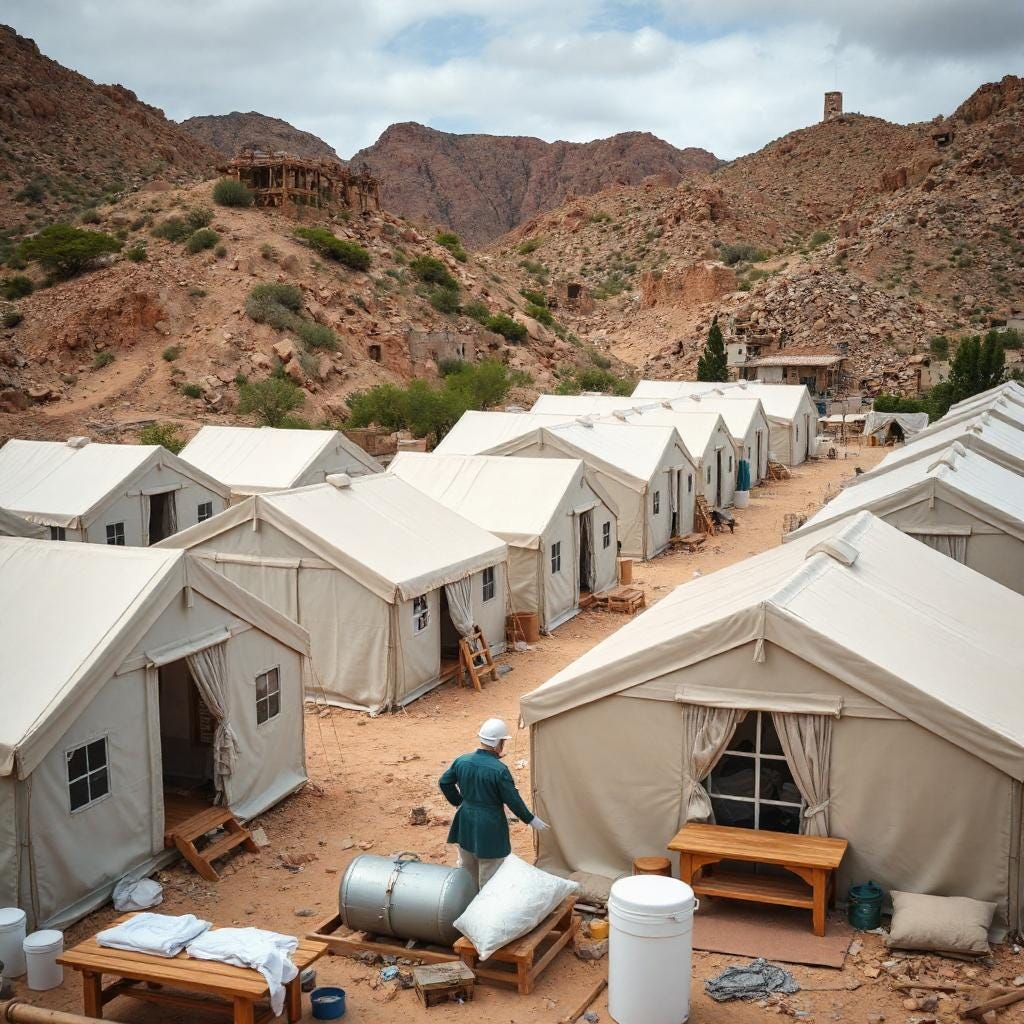Use of the Park Model and Hazard Management Cycle in seismic events
The Park Model and Hazard Management Cycle are both useful frameworks for understanding the impact of seismic events, but they offer different perspectives and applications:
Park Model
The Park Model, also known as the disaster response curve, illustrates how quality of life changes over time in response to a hazardous event like an earthquake
Key features:
Shows the immediate drop in quality of life when a seismic event occurs
Illustrates the stages of response, including search and rescue, relief efforts, and long-term recovery
Demonstrates how quality of life gradually returns to normal (or potentially improves) over time
Usefulness for seismic events:
Provides a clear visual representation of the impact on communities
Helps planners anticipate the timeline of response and recovery
Can be used to compare impacts across different regions or levels of development
Hazard Management Cycle
The Hazard Management Cycle is a continuous process focused on managing hazards through four key stages: mitigation, preparedness, response, and recovery
Key features:
Mitigation: Reducing potential impacts through measures like improved building codes
Preparedness: Planning and training for potential events
Response: Immediate actions during and after an earthquake
Recovery: Long-term rebuilding and restoration efforts
Usefulness for seismic events:
Offers a comprehensive framework for managing earthquake risks
Emphasizes the importance of pre-event planning and mitigation
Promotes continuous improvement in hazard management strategies
Relative Usefulness
While both models are valuable, the Hazard Management Cycle may be more useful overall for understanding and managing seismic events:
Comprehensive approach: The Hazard Management Cycle covers all phases of disaster management, from pre-event planning to long-term recovery
Proactive focus: It emphasizes mitigation and preparedness, which are crucial for reducing the impact of earthquakes
Continuous improvement: The cycle encourages ongoing assessment and refinement of strategies, leading to better preparedness over time
Practical application: It provides a clear framework for emergency managers and policymakers to develop and implement specific strategies
The Park Model, while valuable for visualizing the impact on quality of life, is more descriptive than prescriptive. It helps understand the progression of events but offers less guidance on how to manage them. However, using both models in conjunction can provide a more comprehensive understanding:
The Park Model can illustrate the potential outcomes of effective (or ineffective) hazard management
The Hazard Management Cycle can guide the development of strategies to improve those outcomes
Main Differences in Application
Temporal focus: Park's Model primarily deals with the post-event period, while the Hazard Management Cycle covers all phases before, during, and after an event
Scope: Park's Model is more descriptive, showing how the quality of life changes over time. The Hazard Management Cycle is prescriptive, providing a framework for actions to be taken at each stage
Practical use: Park's Model is often used for analysis and comparison, while the Hazard Management Cycle is used for planning and implementation of hazard management strategies
Flexibility: The Hazard Management Cycle is more adaptable to different types of hazards and contexts, whereas Park's Model is more specific to individual events
Continuous improvement: The Hazard Management Cycle emphasizes ongoing assessment and refinement of strategies, while Park's Model focuses on the progression of a single eventIn practice, both models can be used complementarily:
Park's Model can help visualize the outcomes of hazard management efforts
The Hazard Management Cycle can guide the development of strategies to improve those outcomes
By using both models together, planners and emergency managers can gain a more comprehensive understanding of seismic events and develop more effective strategies for managing their impacts.
Local communities involvement in the coordination efforts during disasters
Local communities play a crucial role in disaster coordination efforts, as they are often the first responders and have the most intimate knowledge of their area's needs and resources. Here are several ways to better involve local communities in disaster coordination:
Establish Pre-Disaster Networks and Structures
Create community-based disaster response teams - Develop local emergency response plans with community input – and Form partnerships between local organizations, citizens, and leaders
Provide Training and Capacity Building
Offer community development and civic engagement training - Teach skills such as asset mapping, needs assessments, and conflict resolution – and Provide training on emergency response procedures and protocols.
Encourage Active Participation
Involve local residents in identifying immediate needs - Include community members in decision-making processes – and Recruit experienced local citizens to take direct action
Leverage Local Knowledge and Resources
Utilise community members' understanding of local vulnerabilities - Tap into existing social networks for information dissemination – and Identify and mobilise local resources and skills
Establish Clear Communication Channels
Create mechanisms for two-way communication between authorities and communities - Use local leaders as liaisons between grassroots efforts and formal structures – and Ensure regular updates and information sharing with community members
Foster Inclusivity and Representation
Ensure diverse representation from different sectors of the community - Include vulnerable and marginalised groups in planning and response efforts – and Promote equitable gender representation in coordination bodies
Build Trust and Relationships
Organise town hall meetings and community forums - Establish community advisory boards to foster local ownership – and Address historical distrust through transparent and inclusive processes
Integrate with Formal Coordination Structures
Include community representatives in official coordination bodies - Establish clear roles and mandates for community involvement – and Ensure community input is incorporated into decision-making processes
By implementing these strategies, disaster coordination efforts can become more effective, responsive, and tailored to local needs. This approach not only enhances the immediate response but also contributes to long-term community resilience and preparedness for future disasters.
In conclusion, while both models contribute to our understanding of seismic events, the Hazard Management Cycle offers greater practical utility for managing and mitigating their impacts. Integrating insights from both models can lead to more effective earthquake preparedness and response strategies.
REFERENCES
"The Park Model: A Framework for Assessing Seismic Risk and Vulnerability" by David Alexander and Barbara Wisner (International Journal of Disaster Risk Reduction, 2004) - This article provides a detailed explanation of the Park Model and its application to seismic events.
"The Hazard Management Cycle: A Framework for Effective Disaster Management" by David Alexander (International Journal of Disaster Risk Reduction, 2006) - This article explores the components of the Hazard Management Cycle and its relevance to seismic events.
"The Park Model and the Hazard Management Cycle: A Framework for Understanding and Managing Seismic Risk" by David Alexander and Barbara Wisner (Disaster Prevention and Management, 2008) - This article provides a comprehensive overview of both the Park Model and Hazard Management Cycle and their application to seismic events.
Monitoring Seismic Activity (U.S. National Park Service) (nps.gov)
FEEL FREE TO BUY ME A COFFEE IF YOU LIKE MY FREE RESOURCES







